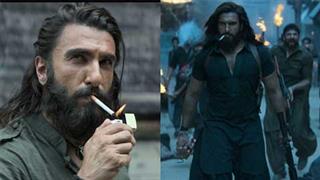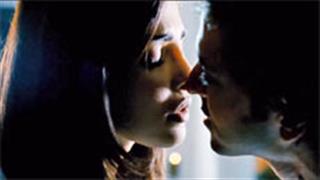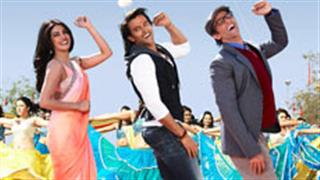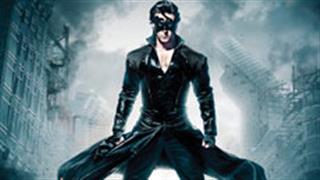It's easier to identify computer-generated imagery (CGI) when a movie belongs to the fantasy genre. But then, what about those scenes in a film which appear totally natural, but aren't? For example, in Aashiqui 2, actor Shraddha Kapoor is shown facing a roaring crowd at a concert. During the actual shoot, the whole stadium was empty and she was standing alone in front of the microphone. Similarly, the bridge scene in Gori Tere Pyaar Mein shows a gently flowing river when, in reality, the water body was far from enchanting. Ditto with the sea adjoining Diu Fort into which the three boys from Kai Po Che jumped. It appeared greener than it actually was.

From facing an empty stadium (above) to one filled with thousands of people (below), VFX certainly goes a long way in Aashiqui 2

Nothing is what it seems in cinema
If one digs a bit deeper, the deception is far more intriguing. And this mystique has a lot to do with visual FX (visual effects or VFX, as it's called) generally applied in the post-production phase. Forget technologically advanced endeavours like Avatar or The Hobbit, even low-budget movies owe a lot to the magic of VFX nowadays. In layman terms, it has become the ultimate Photoshop for moving pictures. There's hardly any film that rolls out of Bollywood without being subjected to VFX. In Bollywood, except for rarities like RA.One or the more recent Krrish 3, VFX is rarely a design element in the narrative process. So the economics boils down to necessity and thus provides scope for special effects on a smaller but broader scale.

Boom goes the car in Krrish 3 post VFX (below), whereas the original shot (above) had none of the drama

Before VFX came along, Digital Intermediate (DI) was the big thing. However, the general perception about that motion picture finishing process was that it was gimmicky. But that was then. As of now DI has become a standard format: every movie goes through a DI process. In contrast, VFX requires allocating funds smartly. Besides, why would a cinematographer shoot in the night for three weeks and increase the production cost when he or she can use visual effects to get the same effects without compromising on any aspect?

The beautiful, flowing river under the bridge (above) in Gori Tere Pyar Mein was created out of a not-so-enchanting stream of water (below)

Prime Focus, one of the key players in the field, makes life easier during a time-crunch. This year, the company played a significant role in successful films such as Aashiqui 2, Kai Po Che and Yeh Jawaani Hai Deewani. Currently working on Salman Khan's Jai Ho, its co-founder and chief creative director Merzin Tavaria throws light on the rise of visual effects with respect to cost. `In Bollywood, 2008-2009 saw some movies such as Ghajini, Raaz 2 and Chandni Chowk to China embrace VFX like never before. But it fizzled out with the global recession. As a result, smaller movies such as Aamir and Dev D started to bloom. For VFX, it was an interesting trend because we later noticed that the ratio comparison between small as well as big-budget movies is almost the same.`
Compared to Hindi filmmakers, their southern counterparts are more innovative vis-a-vis VFX. For them, it is a creative tool for innovative storytelling as evident from blockbusters such as Robot, Eega (Makkhi) and Magadheera. Turns out they have not let their imagination suffer due to budgetary restrictions. But money isn't always the issue. Approach is.
Vamsi Ayyagari, general manager of Moving Picture Company, points out the misconception. `It is a mistaken belief that VFX is expensive. Yes, it may comprise 20 per cent or even 50 per cent of a movie budget but in such cases, the film can't be made without VFX. Moreover, it saves money that otherwise will be spent on other elements of filmmaking,` says the Bangalore-based professional who has earlier worked on Koi Mil Gaya, Aladin and Where the Wild Things Are. Both filmmaking and VFX, are creative processes that require streamlining and foresight.
Reliance MediaWorks knows a thing or two about both. It recently delivered a whopping 750-plus VFX shots for the Imran Khan-Kareena Kapoor Khan-starrer Gori Tere Pyaar Mein and was in a position to help shape the overall aesthetics of the film set in a rustic part of Gujarat. The aforementioned bridge forms a crucial element in the storyline. The structure was a textured computer-generated representation of a real bridge. It had to be highly detailed as a large number of close-up shots were supposed to be filmed on the bridge. For the river, various shots of a lake were taken which were then given depth and magnitude using the VFX technology.
Venkatesh Roddam, CEO of Reliance MediaWorks, adds, `Most of the VFX in the film is not even visible. However, the elements that have been created as part of the VFX for the movie play an essential role in the plot, thereby making the taskof handling the VFX that much more creatively challenging and significant.`
For the film's director Punit Malhotra, the marriage between the storyline and the technology available at hand mattered the most. `Neither does the storyline indicate special effects nor is that highlighted in the communication. So, the transition of the VFX into the frames had to be seamless and almost invisible for the viewer.`
Alert: Bumps ahead
When there are so many advantages of a technology, wouldn't there be some demerits as well? Tavaria affirms and belts out a few. `VFX is a cinematic trick so we don't like to reveal what we do. But at the same time, its strength has become its weakness. We like to exceed expectations but sometimes, there's no need to alter anything. Also, it's often misunderstood that visual effects is a part of post-production when it's actually a part of filmmaking in general. VFX ought to come in at the beginning of the film when the script of the movie is being penned, which is not the case yet,` he elaborates. Ayyagari, too, sheds light on what needs to improve with respect to global competition. He maintains that VFX has always been a low-margin business and excessive undercutting has stunted the industry's growth. `Also, Indian companies need to work on design, quality and execution. In future, technological innovations such as Performance Capture and Cloud Computing will be differentiators and such tools will help tell bigger stories. However, the domestic Indian VFX Industry has to start respecting itself.`
What the future holds
According to Keitan Yadav, CEO of Red Chillies VFX and Harry Hingorani, creative director, VFX will only see growth in Hindi film industry. He explains, `One of the main reasons for increasing use of VFX in Bollywood is that writers, producers and directors are increasingly touching upon new genre and stories which are impossible to make without extensive involvement of VFX professionals. Krrish 3 is a testimony to the increasing use of VFX in Bollywood where almost every shot in the film utilised VFX to make the movie visually stunning and appealing. With the help of a talent pool, at a fraction of Hollywood budgets, Bollywood is bound to use it extensively.`
Pankaj Khandpur, creative director of Tata Elxsi -- Visual Computing Labs, echoes similar sentiments. `Over the last few years, one change that we have observed is the mindset of filmmakers and their openness to experiment with new VFX technology. They are now writing stories that integrate VFX in the creative process from the script stage itself. What also helps is that we get involved in the project right from the script stage. This has enabled us to use some of the most cutting-edge and path-breaking VFX technology for our recent projects such as Dhoom 3, Bhaag Milkha Bhaag and Ek Tha Tiger,` he says.
Despite the endless possibilities ahead, the rise of VFX is a noteworthy change in Hindi cinema. But going by the experts in the field, it requires the combined mastery of mind and art -- and musn't be treated like just another step in the assembly line of filmmaking.

















